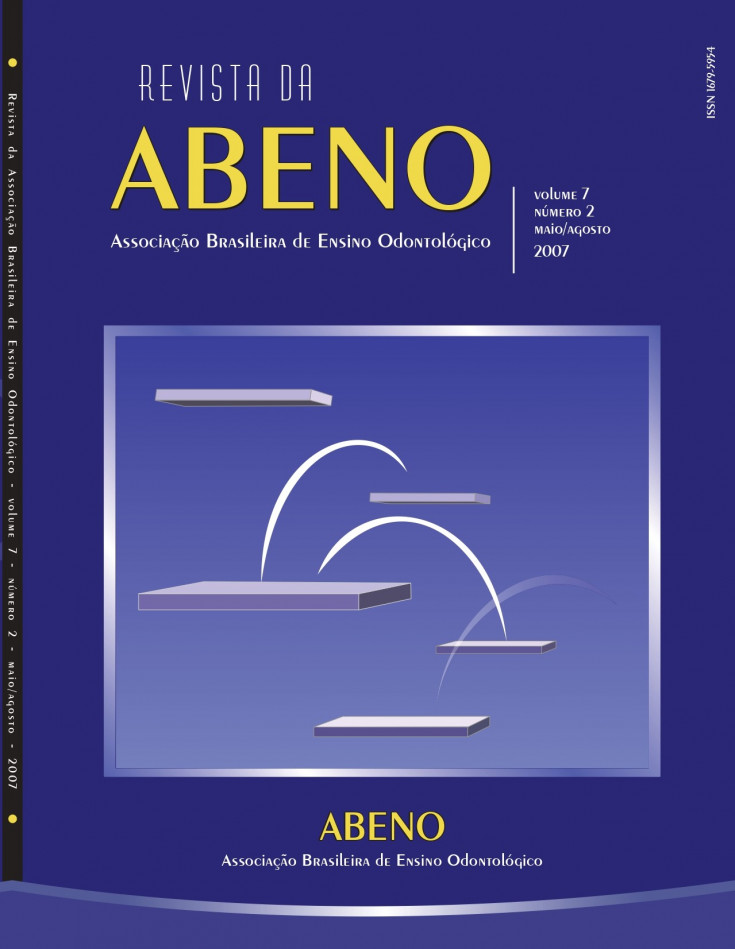Evaluation of the effectiveness of the geometric method in the learning of dental sculpture at a dental undergraduate course
DOI:
https://doi.org/10.30979/rev.abeno.v7i2.1387Keywords:
Sculpture. Anatomy. Learning.Abstract
A dental student must develop an esthetic perception and be able to analyze the shape and function of teeth in order to correct and reestablish the complete physiology and beauty of the stomatognathic system in his or her patients. The dental sculpture discipline aims to develop and train the student’s manual ability, preparing him or her for other disciplines which also require this ability. The purpose of this project was to evaluate the effectiveness of the geometric method for dental sculpture teaching among beginners with different initial degrees of manual ability. The geometric method as an auxiliary tool in dental sculpture teaching made better results possible, helping the students to learn the technique as well as the reproduction of dental anatomy. The result showed that, although the method proved to be effective with all the students, those who already had demonstrated a greater facility at the beginning of the course were able to take fuller advantage of the method. An improvement was observed in the manual training, in the perception of the teeth’s anatomic details, and in the perception of proportion between the different dental elements.Downloads
References
Bogacki RE, Best A, Abbey LM. Equivalence Study of a Dental Anatomy Computer-Assisted Learning Program. J Dent Educ. 2004;68(8):867-71.
Cantisano W, Palhares RW, Santos HJ. Anatomia Dental e Escultura. 3ª ed. Rio de Janeiro: Guanabara Koogan; 1987.
Della Serra O. Anatomia dental. 2ª ed. Rio de Janeiro: Científica; 1995.
Ford TRP. Teaching tooth morphology to dental students. Br Dent J. 1974;132:169-73.
Lorenzato S. Por que não ensinar Geometria? Revista da SBEM. 1995;4:3-13.
Pao YC, Reinhardt RA, Krejci RF, Taylor DT. Computer-graphics aided instruction of three-dimension dental anatomy. J Dent Educ. 1984;48(6):315-7.
Romerowski J, Bresson G. Changing the teaching of dental anatomy to change the mental habits of dental practitioners. Int J Periodontics Restorative Dent. 1985;5(2):52-67.
Santos Júnior J, Fichman DM. Escultura e modelagem dental. 6ª ed. São Paulo: Santos; 2000.
Steagall L, Santos Jr J, Wajngarten I, Guido D. Desenho e Escultura Dental. São Paulo: Faculdade de Odontologia da USP; 1966.
Vieira GF, De Caroli A, Garófalo JC, Matson E. Escultura Dental com auxílio do método geométrico (revisão anatômica). 3ª ed. São Paulo: Gnatus; 2002.
Wheeler RC. A manual: Tooth Form Drawing and Carving. Philadelphia: WB Sanders Company; 1940.
Whittaker DK, Marshall RJ, Evan RW. The use of videotapes in teaching tooth morphology. J Dent Educ. 1989:53(10):581-3.
Downloads
Published
How to Cite
Issue
Section
License
Autores que publicam nesta revista concordam com os seguintes termos:
a) Autores mantém os direitos autorais e concedem à revista o direito de primeira publicação, com o trabalho simultaneamente licenciado sob a Licença Creative Commons Attribution que permite o compartilhamento do trabalho com reconhecimento da autoria e publicação inicial nesta revista.
b) Autores têm autorização para assumir contratos adicionais separadamente, para distribuição não-exclusiva da versão do trabalho publicada nesta revista (ex.: publicar em repositório institucional ou como capítulo de livro), com reconhecimento de autoria e publicação inicial nesta revista.
c) Autores têm permissão e são estimulados a publicar e distribuir seu trabalho online (ex.: em repositórios institucionais ou na sua página pessoal) a qualquer ponto antes ou durante o processo editorial, já que isso pode gerar alterações produtivas, bem como aumentar o impacto e a citação do trabalho publicado (Veja O Efeito do Acesso Livre).






